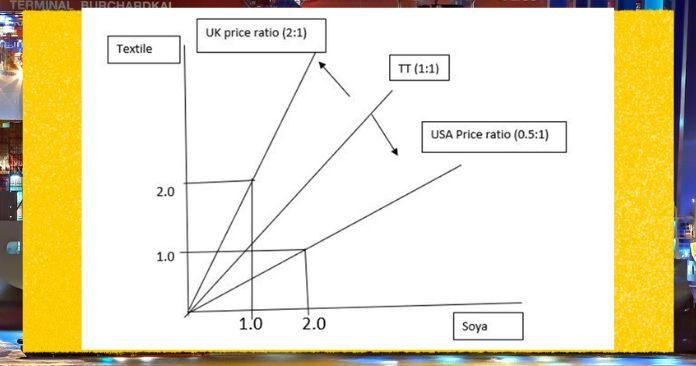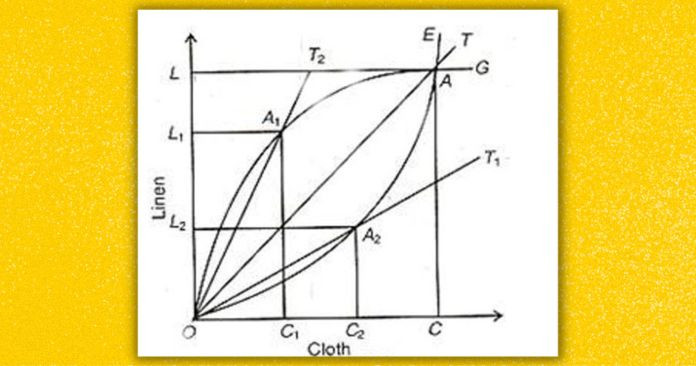From this article, you will learn about three important concepts of international trade which referred to as terms of trade, reciprocal demand, and offer curves.
It highlights how to determine prices of international trade between two countries and equalization of terms of trade.
At the end of the article, you will be able to understand how international trade equilibrium occurred after entering the international trade through reciprocal demand and offer curves.
Equalization of Terms of Trade
According to two goods and two country model of comparative advantage, equalization of terms of trade becomes an important aspect that determines the international price for mutually beneficial trade.
What is comparative advantage?
Thus after entering for international trade by two countries, international trade will determine on the new price line that based on the autarky prices of two countries.
Though the Recardian model relies mainly on the supply conditions, the model was developed to explain the equilibrium of TOT, which base on the autarky prices of each trade partner.
Terms of Trade (TOT) Example
As shown in figure 1, if the autarky price ratios of the country A is 0.5:1 and 2:1 in country B, the country A will not export soya less than the domestic price ratio of 0.5, and country A’s domestic price line (0.5) become their no-trade boundary and the country B’s domestic price ratio (2:1 ) becomes country B’s no-trade boundary.
The mutually beneficial trade is bounded by the cost ratio of the two nations. Thus both countries will work on the world price as TT (1:1) in between two autarky prices.

Reciprocal Demand
Reciprocal demand is a process of international interaction of demand and supply that necessary to establish international price equilibrium.
This idea was presented by John Stuart Mill in1873 and it was further developed by Alfred Marshall.
The theory suggests that the actual price at which trade takes place depends on the trading partners’ interacting demands.
The theory works similarly as the demand and supply pattern in other markets. Thus if demand does not equal to supply in world markets, the international price will change until it becomes equal.
Thus equalization of terms of trade depends on the demand and supply conditions for goods.
Reciprocal Demand Example
For instance, if we consider the two goods two-country model as soya (S) for USA and textile (T) for the UK, the stronger the UK demand for S relative to the US demand for T, the terms of trade will settle to UK’s domestic price ratio.
The reverse equally happens for the USA if the USA makes high demand for textile. Thus reciprocal demand contends that the equilibrium of trade depends on the relative strength of the demand of each nation for other nations’ products.
The reciprocal demand theory can apply best when both nations are of equal economic size. Under the situation of unequal economic size, it is possible that the relative demand strength of the smaller nation will be dominated and consequently price rates of the larger country will remain.
Offer Curves
The concept of reciprocal demand is measured by offer curves. Hence offer curves refer as reciprocal demand curves as well. It was derived and introduced by Alfred Marshall and Ysidro Edgewarth in the 20th century.
The offer curve of a nation shows the nations willingness to import and export at various relative commodity prices. It is derived from the nation’s production frontier, commodity indifference curve, and the various relative commodity prices or trade lines.
Thus country A’s offer curve could be derived from trade equilibrium curves and similarly offer curve for country B could be drawn according to the production possibility frontier (PPF), terms of trade (tot), and community indifference curve (CIC) of country B.
Thus If we assume that Country A produces and sell its low-cost production of cloth, its offer curve is presented by line E, Similarly, the country B produce and sells its low-cost commodity linen, it’s offer curve indicated by line G. The interaction of the offer curves of country A and B is defined as the equilibrium of offer curves where indicated at point A. Thus the offer curves of both countries intersect at the point where TOT is equal to 1:1 as shown in figure 2.
Offer Curve, Equalizing TOT between two nations

Do you want to know more about international trade? Refer to the below articles.
International trade microeconomics
Classical International Trade Theory | absolute advantage
What is comparative advantage?
International Trade and Economic Development
Rate the article if you learned something new from it.
⭐⭐⭐⭐⭐


